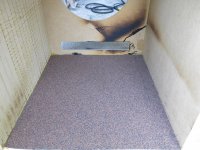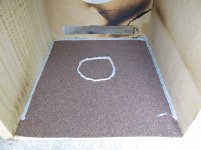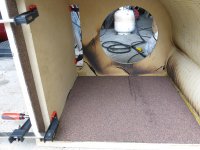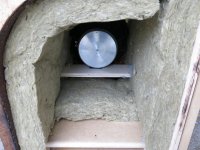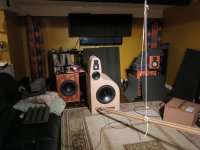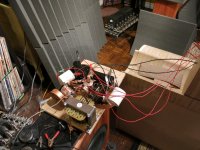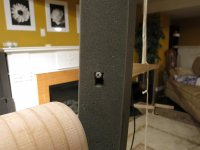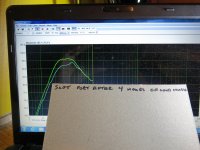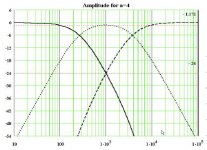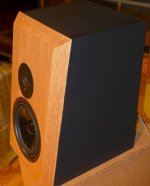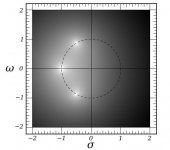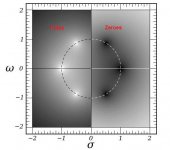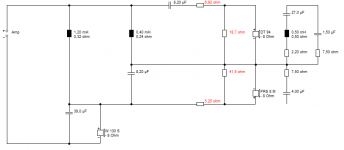My woofer test box is finished.
Pic. 1) The side curved wall is 1 1/2" MDF. The bottom plate is 3/4" Baltic Birch Ply (it'll grab the spikes better than MDF). The large side is MDF. The front baffle is MDF. In roofing we use SBS. This is a synthetic rubber. I'm torching it to the inner walls (dampening the walls).
Pic. 2) I'll use Dymonic caulking to hold the next piece of MDF in place. The donut caulk is to stop the MDF from slapping the SBS.
Pic. 3) I turned the cabinet on it's side, torched down the next piece, and clamped the MDF against the caulking.
Pic. 4) Installed Baltic Birch over the SBS to the large MDF face. Installed the slot port. Torched SBS to the curved side. Installed Roxul Safe and Sound insulation.
Screwed the back wall into place (closed cell foam in the gap).
I can tell you the port tuning showed 35Hz. This is obviously wrong. I thought it might be the Roxul, so I removed it. No change. I think the woofer needs some time to loosen up. Time to listen to music.
Pic. 1) The side curved wall is 1 1/2" MDF. The bottom plate is 3/4" Baltic Birch Ply (it'll grab the spikes better than MDF). The large side is MDF. The front baffle is MDF. In roofing we use SBS. This is a synthetic rubber. I'm torching it to the inner walls (dampening the walls).
Pic. 2) I'll use Dymonic caulking to hold the next piece of MDF in place. The donut caulk is to stop the MDF from slapping the SBS.
Pic. 3) I turned the cabinet on it's side, torched down the next piece, and clamped the MDF against the caulking.
Pic. 4) Installed Baltic Birch over the SBS to the large MDF face. Installed the slot port. Torched SBS to the curved side. Installed Roxul Safe and Sound insulation.
Screwed the back wall into place (closed cell foam in the gap).
I can tell you the port tuning showed 35Hz. This is obviously wrong. I thought it might be the Roxul, so I removed it. No change. I think the woofer needs some time to loosen up. Time to listen to music.
Attachments
I measured the slot port output with the brand new woofer. ???
After 4 hours of music (2 days), I measured again. Much better.
Think I'll listen for a few more weeks before measuring again.
After 4 hours of music (2 days), I measured again. Much better.
Think I'll listen for a few more weeks before measuring again.
Attachments
Last edited:
Hello Jonasz
Long story made short ish.
The base is out of this world. The AE TD15H+ is ripping the MDF test box apart.
My CNC guy, whose name is Guy, should have the 100+ pieces ready by next week. This time I will build both speakers.
The final speaker will be made from 24mm Baltic Birch Ply.
If you recall, a normal series crossover says do the parallel calculation, halve the inductors, and double the capacitors. This is plain wrong for a 4-way.
Once the final speakers are finished, I'll do less waffling, and more maple syrup ing. I'll show you step by step how to build one.
The Fully Balanced Dual Cascade Paralleled SERIES 4-way crossover is the greatest crossover on the planet. Period. Care must still be taken in driver selection.
Euphoria Speaker Design & the Fully Balanced Dual Cascade Paralleled SERIES 4-way crossover - EUPHORIA SPEAKER DESIGN & the Fully Balanced Dual Cascade Paralleled SERIES 4-way crossover
Long story made short ish.
The base is out of this world. The AE TD15H+ is ripping the MDF test box apart.
My CNC guy, whose name is Guy, should have the 100+ pieces ready by next week. This time I will build both speakers.
The final speaker will be made from 24mm Baltic Birch Ply.
If you recall, a normal series crossover says do the parallel calculation, halve the inductors, and double the capacitors. This is plain wrong for a 4-way.
Once the final speakers are finished, I'll do less waffling, and more maple syrup ing. I'll show you step by step how to build one.
The Fully Balanced Dual Cascade Paralleled SERIES 4-way crossover is the greatest crossover on the planet. Period. Care must still be taken in driver selection.
Euphoria Speaker Design & the Fully Balanced Dual Cascade Paralleled SERIES 4-way crossover - EUPHORIA SPEAKER DESIGN & the Fully Balanced Dual Cascade Paralleled SERIES 4-way crossover
I have almost the same drivers as you laying around, although it's the TD15X and a couple different tweeters. Interesting to see what you come up with. Haven't even decided if I'm going active or passive yet or if I indeed need the C50 in the mix, guess that depends on wich tweeter I decide to use. 🙂
I have almost the same drivers as you laying around, although it's the TD15X and a couple different tweeters. Interesting to see what you come up with. Haven't even decided if I'm going active or passive yet or if I indeed need the C50 in the mix, guess that depends on wich tweeter I decide to use. 🙂
Jonasz, the TD15X is perfect.
It's designed to be ported, so a slot port would be my recommendation. Model your tuning below the Fs (Helmholtz I believe is the name. It sums in phase).
It's mid 90's in efficiency. The -3dB baffle loss means it will mate well with a 90-91dB mid range. A great filler for a 4-way is obviously the TD6M, but I'm also looking at some of the PHL Audio 6 inchers.
The Accuton C50 is discontinued. The C51 is around 93dB. This might require resistors.
I've never gone active. I do know my previous speaker with a DSP and 1500watt plate amp can't compare to what I'm getting now.
Congrats Cousin
Cousin I like and admire the time and effort you have put into this project. I would like to know how much you would charge me to build me a 4-way crossover for my project. If you remember I have a pair of TD12s 93db 8ohm versions for each enclosure, with a single TD6m 93db 8ohm, a single audax HM100Z0 4" 8ohm 93db upper mid, and a Audax TW025A20 8ohm 93db metal dome tweeter unless I find a tweeter that makes a big enough diff to justify the extra cost. You're a blessing to this community! Thanks again.
PS: The audax mid and tweeter should compliment each other great. I have a friend who thinks that because of the TD12s ability to play up into the 800hz range a 3-way with just the dual TD12s, TD6m, & TW025A20 would be a killer design and if anything get an even better tweeter like the Seas Excel T29B001 Beryllium Dome Tweeter (E0058).
Cousin I like and admire the time and effort you have put into this project. I would like to know how much you would charge me to build me a 4-way crossover for my project. If you remember I have a pair of TD12s 93db 8ohm versions for each enclosure, with a single TD6m 93db 8ohm, a single audax HM100Z0 4" 8ohm 93db upper mid, and a Audax TW025A20 8ohm 93db metal dome tweeter unless I find a tweeter that makes a big enough diff to justify the extra cost. You're a blessing to this community! Thanks again.
PS: The audax mid and tweeter should compliment each other great. I have a friend who thinks that because of the TD12s ability to play up into the 800hz range a 3-way with just the dual TD12s, TD6m, & TW025A20 would be a killer design and if anything get an even better tweeter like the Seas Excel T29B001 Beryllium Dome Tweeter (E0058).
Last edited:
Good morning Mr. F. Keller.
I would be honoured (That's how we spell honored here in Canada. We also spell color, colour).
COST?. My wife likes Ferrero Rocher chocolate. Send her a care package. For me, I would like 'Euphoria Edition' put somewhere on the speaker.
1) I think we should start a new thread. I would like your permission to do so.
The Fully Balanced Dual Cascade Paralleled Series 4-way crossover is the greatest crossover in human history. If we imbed your build in this thread, many won't see it. If you read my website, some of my claims appear outrages. Wait till you hear it for yourself.
2) There is a 3dB baffle loss from your low drivers (TD12S & TD6M). This means when we are done, you will have to pad down you Audax's. Sorry, your going to have to do some work.
3) Smile. You're about to build one of the best speakers on planet Earth.
I would be honoured (That's how we spell honored here in Canada. We also spell color, colour).
COST?. My wife likes Ferrero Rocher chocolate. Send her a care package. For me, I would like 'Euphoria Edition' put somewhere on the speaker.
1) I think we should start a new thread. I would like your permission to do so.
The Fully Balanced Dual Cascade Paralleled Series 4-way crossover is the greatest crossover in human history. If we imbed your build in this thread, many won't see it. If you read my website, some of my claims appear outrages. Wait till you hear it for yourself.
2) There is a 3dB baffle loss from your low drivers (TD12S & TD6M). This means when we are done, you will have to pad down you Audax's. Sorry, your going to have to do some work.
3) Smile. You're about to build one of the best speakers on planet Earth.
opinions
Lets here everybodys opinions on what you think would be the best mid and tweeter combo. Give your opinions.
Lets here everybodys opinions on what you think would be the best mid and tweeter combo. Give your opinions.
The Fully Balanced Dual Cascade Paralleled Series 4-way
crossover is the greatest crossover in human history.
Hi,
Sadly your very technically deluded. It is very boring.
rgds, sreten.
Lets here everybodys opinions on what you think would be the best mid and tweeter combo. Give your opinions.
I think the mid has to be a very capable and well behaved driver. Perhaps a fullranger.
B 80 - 8 Ohm
Cousin Billy is actually onto something here, despite sreten's misgivings. He's reinvented Bud Fried's ideas. Bud Fried was a great fan of damped transmission lines and employed series filters on occasion, though not exclusively. Bud used KEF bextrene drivers like B200, B110 and T27 quite often.
First I'll give you the history lesson. Then some sims with modern drivers. It's a remarkable circuit with very flat impedance, which works with a lot of stuff just by adjusting the resistors. You can put a capacitor in the tweeter section without much change beyond steeper rolloff. It gets better when you add impedance correction and some LC values are not written in stone, but that's for another day. 🙂
I've never heard this speaker, but it is certainly interesting. I would guess driver selection is critical.
Attachments
-
 Fried Model H Electrical.PNG22.2 KB · Views: 115
Fried Model H Electrical.PNG22.2 KB · Views: 115 -
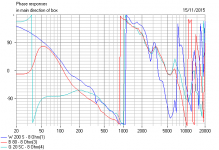 Fried Model H Phase.PNG29.2 KB · Views: 131
Fried Model H Phase.PNG29.2 KB · Views: 131 -
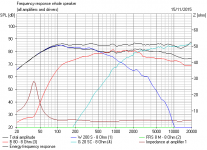 Fried Model H FR.PNG23.7 KB · Views: 352
Fried Model H FR.PNG23.7 KB · Views: 352 -
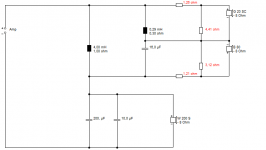 Fried Model H Sim Circuit.PNG7.8 KB · Views: 349
Fried Model H Sim Circuit.PNG7.8 KB · Views: 349 -
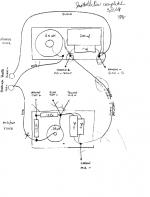 Fried Series Crossover.PNG39.5 KB · Views: 350
Fried Series Crossover.PNG39.5 KB · Views: 350 -
 Fried TL.JPG17.4 KB · Views: 345
Fried TL.JPG17.4 KB · Views: 345 -
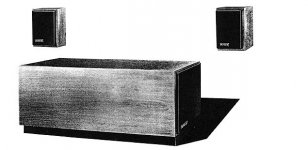 Fried Model H.JPG39.9 KB · Views: 340
Fried Model H.JPG39.9 KB · Views: 340
Steve,
As always, you are a fountain of knowledge. Your ability to recall obscure facts from the past is unparalleled. I need to research Bud Fried's work.
Believe it or not, sreten is also one I've followed for years. Once I am done, and my speakers have been heard by others, I will be satisfied.
At this point my arrogance is unsubstantiated. sreten is correct, I am technically naïve.
Add Troels and Tony G. to the 'help others' camp, and we see why my crossover is open.
With all of your help, I have reached a point where I'm finally happy with my speakers.
Regards
Bill Laleff
Euphoria Speaker Design & the Fully Balanced Series x-over
As always, you are a fountain of knowledge. Your ability to recall obscure facts from the past is unparalleled. I need to research Bud Fried's work.
Believe it or not, sreten is also one I've followed for years. Once I am done, and my speakers have been heard by others, I will be satisfied.
At this point my arrogance is unsubstantiated. sreten is correct, I am technically naïve.
Add Troels and Tony G. to the 'help others' camp, and we see why my crossover is open.
With all of your help, I have reached a point where I'm finally happy with my speakers.
Regards
Bill Laleff
Euphoria Speaker Design & the Fully Balanced Series x-over
Keep at it, Bill. I'm a latecomer to this thread and am not entirely up to speed on what you are doing.
What I do think is that these shallow crossovers need very smooth drivers. Your additional capacitor on the tweeter will help distortion too. IIRC, the bass and tweeter are a mere 6 or 12dB/octave.
I really don't know quite what is going on here, but you must be close to a transient perfect speaker.
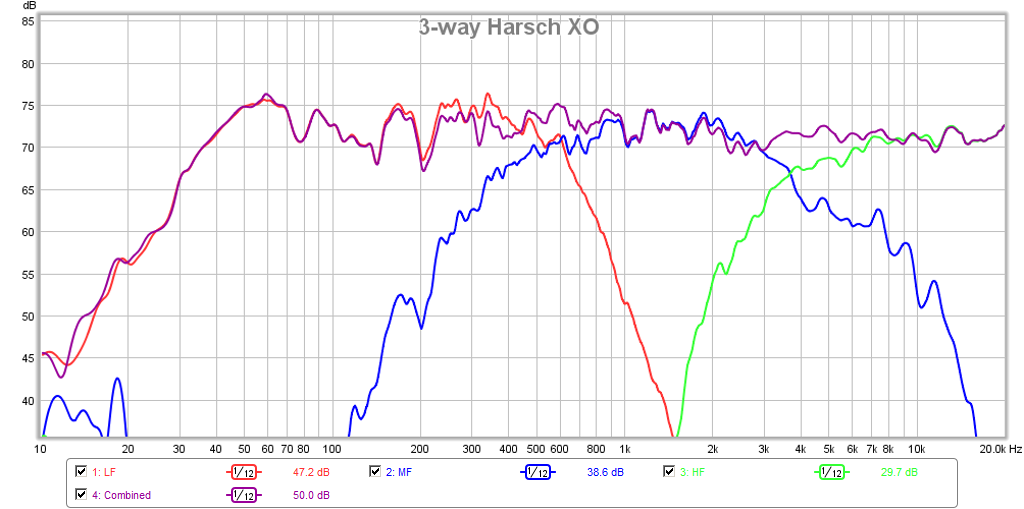
http://www.diyaudio.com/forums/multi-way/277691-s-harsch-xo.html
What I do think is that these shallow crossovers need very smooth drivers. Your additional capacitor on the tweeter will help distortion too. IIRC, the bass and tweeter are a mere 6 or 12dB/octave.
I really don't know quite what is going on here, but you must be close to a transient perfect speaker.

http://www.diyaudio.com/forums/multi-way/277691-s-harsch-xo.html
opinions
Ok, all you guys are doing a great job chiming in and thats what our audiophile community needs. We must type our thoughts so others can learn and grow in this addicting and fun hobby. Keep the class going, I have a hunger for knowledge about this hobby, i'm learning every minute and I am appreciative to attend such a class with great teachers. Gentlemen teach on. Thanks again.
Ok, all you guys are doing a great job chiming in and thats what our audiophile community needs. We must type our thoughts so others can learn and grow in this addicting and fun hobby. Keep the class going, I have a hunger for knowledge about this hobby, i'm learning every minute and I am appreciative to attend such a class with great teachers. Gentlemen teach on. Thanks again.
Last edited:
It's rare for diyaudio to get so enthusiastic and complimentary about something, but here it is justified IMO. 😀
I haven't run the sim for the 4 way version of this speaker yet. But I CAN give you the mathematical justification for it. It's the sort of thing John Kreskovsky and myself find interesting.
1) 3 ways can be based on simple transfer functions like 1 - 2s + s^2 / 1 + 2s + s^2.
2) 4 ways might employ 1 - 3s + 3s^2 -s^3 / 1 + 3s + 3s^2 +s^3.
This in mathematics is function of a complex variable s representing jw or frequency. Bud Fried's ideas are based on the first function. Cousin Billy is doing something with the second.
To see the power of these ideas, look at the Steen Duelund classic 3 way filter below.
The next two images are my own take on a time-aligned two way.
The last two have a resemblance and relation to what Cousin Billy is doing in the powerful pole zero representation. Just enjoy the symmettry at this point, but be assured that those images can represent a 4 way speaker. 😎
I haven't run the sim for the 4 way version of this speaker yet. But I CAN give you the mathematical justification for it. It's the sort of thing John Kreskovsky and myself find interesting.
1) 3 ways can be based on simple transfer functions like 1 - 2s + s^2 / 1 + 2s + s^2.
2) 4 ways might employ 1 - 3s + 3s^2 -s^3 / 1 + 3s + 3s^2 +s^3.
This in mathematics is function of a complex variable s representing jw or frequency. Bud Fried's ideas are based on the first function. Cousin Billy is doing something with the second.
To see the power of these ideas, look at the Steen Duelund classic 3 way filter below.
The next two images are my own take on a time-aligned two way.
The last two have a resemblance and relation to what Cousin Billy is doing in the powerful pole zero representation. Just enjoy the symmettry at this point, but be assured that those images can represent a 4 way speaker. 😎
Attachments
Last edited:
Thank you Steve.
I was worried my ideas where off the charts. You've quelled my fears I was doing something wrong.
Let's talk time alignment.
We have the physical acoustic centers of the drivers. I believe Z-offset is the word we use.
We have the offset imparted on the signal by our crossover.
When I was testing my tweeter/midrange 'alignment' output, I used Jeff Bagley's trick. I positioned my microphone a few inches in front of the drivers. I then started 'lifting' the front of my baffle. The back of the cabinet remained stationary. I did lift the microphone by the same amount each time. This started to cause a 'perceived' slanting of the baffle. The tweeter was getting further away.
I lifted the front in 1/4" increments. I made it to 3" (that's a lot of tests). The peaks and valleys changed position, but their amplitude remained the same.
I then had a thought, what would happen if I slanted the baffle 'forward'. I returned the front of the baffle to flat, and started to raise the back.
Bingo. At the 1/2" mark the amplitude of the peaks and valleys was cut in half.
I will postulate my crossover causes the tweeter signal to 'lag' the midrange signal. Positioning the tweeter in front of the midrange brings things together.
Did I do that correctly?
I was worried my ideas where off the charts. You've quelled my fears I was doing something wrong.
Let's talk time alignment.
We have the physical acoustic centers of the drivers. I believe Z-offset is the word we use.
We have the offset imparted on the signal by our crossover.
When I was testing my tweeter/midrange 'alignment' output, I used Jeff Bagley's trick. I positioned my microphone a few inches in front of the drivers. I then started 'lifting' the front of my baffle. The back of the cabinet remained stationary. I did lift the microphone by the same amount each time. This started to cause a 'perceived' slanting of the baffle. The tweeter was getting further away.
I lifted the front in 1/4" increments. I made it to 3" (that's a lot of tests). The peaks and valleys changed position, but their amplitude remained the same.
I then had a thought, what would happen if I slanted the baffle 'forward'. I returned the front of the baffle to flat, and started to raise the back.
Bingo. At the 1/2" mark the amplitude of the peaks and valleys was cut in half.
I will postulate my crossover causes the tweeter signal to 'lag' the midrange signal. Positioning the tweeter in front of the midrange brings things together.
Did I do that correctly?
It's hard for me to answer that without a lot more work.
I always find time-alignment is critical with shallow series filters. Having said that, there are some tricks to employ with flipping polarity and you sometimes get lucky with shallow mids which are nearly time aligned anyway.
You MAY find that polarity alternatively flips on each of the 4 drivers. IDK.
What often helps is impedance correction. In the below example, I had good success correcting the Fs resonance and rising inductance of the tweeter and mid. Those correction circuits may be wired in simply.
Bear in mind that my own interest is mainly mathematical.
I always find time-alignment is critical with shallow series filters. Having said that, there are some tricks to employ with flipping polarity and you sometimes get lucky with shallow mids which are nearly time aligned anyway.
You MAY find that polarity alternatively flips on each of the 4 drivers. IDK.
What often helps is impedance correction. In the below example, I had good success correcting the Fs resonance and rising inductance of the tweeter and mid. Those correction circuits may be wired in simply.
Bear in mind that my own interest is mainly mathematical.
Attachments
- Status
- Not open for further replies.
- Home
- Loudspeakers
- Multi-Way
- 4-Way Series Crossover. Accuton and Acoustic Elegance Drivers
